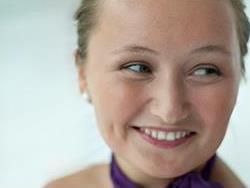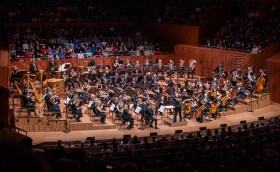Julia Lezhneva in Baroque Brilliance. Image via Australian Chamber Orchestra.
It’s rare that the Australian Chamber Orchestra devotes themselves so wholly to the music of the 18th century, but given the guest artist for this program, the majestic parade of Bach, Handel, Vivaldi and Porpora was entirely appropriate. Russian soprano Julia Lezhneva is a specialist in music of this period, and displays such a mastery of its demanding, idiosyncratic vocal style and sensibilities that it’s as if she has access to a time machine. How else can one explain such Baroque brilliance from a 26-year-old singer?
The concert began with the Porpora motet, In caelo stelle clare fulgescant, a relatively demure work compared to the vocal fireworks that would come later. Indeed, there was an almost mezzo quality to Lezhneva’s tone here. She returned to bookend the first half of the program with Handel’s Salve Regina, the highlight of which was the third movement’s joyous interplay between strings, organ and the bright, pure notes that tumbled from Lezhneva like birdsong.
Between these two virtuoso displays of coloratura singing, the orchestra took centre stage for JS Bach’s Orchestral Suite No. 1 in C major. Playing on gut strings and stripped back to about a dozen players, the ACO were joined by some notable Baroque specialists for this concert, such as Axel Wolf on theorbo and Pinchgut Opera’s artistic director Erin Halyard on harpsichord and chamber organ. The guest woodwind trio, including oboist Benoît Laurent, were prominent in this first half’s instrumental work, weaving in out of a gracious, richly textured performance.
The ensemble opened the second half of the program with a perky interpretation of the sinfonia from Vivaldi’s Ottone in Villa, and later took centre stage again with Handel’s Sonata No. 5 in B-flat major, for which Richard Tognetti lived up to his frontman status as quasi-soloist. Slightly marred by some occasional squeaky violin, it was otherwise disciplined and expressive.
After impressing in the first half, Lezhneva completely dazzled in the second, delivering several Handel arias that showcased her agile, ringing top notes, emphatic articulation and frenetic runs that seemed astonishingly effortless. Once again, expressiveness was also to the fore, never more so than in Un pensiero nemico di pace, delivered with such ferocity that it made my heart pound. After concluding in suitably brilliant fashion with a pair of arias from Allessandro, the songbird returned for two encores (the delighted audience were probably hoping for 20), including a familiar little sweet to end the evening, Handel’s Lascia la spina.
With her innocent face and petite stature, and smiling, humble attitude – she frequently applauded and acknowledged the orchestra – Lezhneva’s youth is apparent at every moment (indeed she could pass for a teenager). This makes her technical excellence and maturity of expression seem even more astonishing for concertgoers, and begs the question: can this singer reach even greater heights in the decades to come?
Rating: 4 1/2 stars out of 5
Baroque Brilliance
Australian Chamber Orchestra
Director and violin Richard Tognetti
Soprano Julia Lezhneva
Melbourne Recital Centre
15 October 2016





